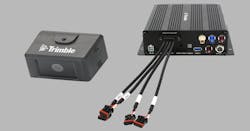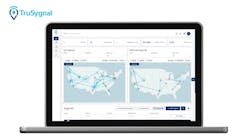At the heart of a truck driver fatigue warning system delivered through a partnership between Trimble Transportation and Pulsar Informatics is that latter company's wealth of fatigue and sleep research from the aviation, aerospace, and other safety-sensitive industries. But Trimble's Jim Angel explained even that wasn't enough.
Pulsar, founded in 2001, has studied sleep patterns and monitored fatigue for the likes of astronauts and pilots—who, like truck drivers, have work hours governed by regulations for safety reasons—and gauges a truck driver's fatigue levels using Hours of Service (HOS) data in the company's Trucking Fatigue Meter.
Drivers get a safety risk rating similar to Trimble's: green, yellow, or red status, with red being a potential safety warning. "We have a very, very firm belief in what they do," said Angel, Trimble's VP of Video Intelligence Solutions, of Pulsar's fatigue monitoring. "These guys are absolutely brilliant people."
Still, one size doesn't fit all when it comes to fatigue, he added. "You and I might be completely different in how we react to fatigue," Angel told Fleet Owner. "Let's say both of us have been busy all day; we both got a two-hour nap.
"You might feel like driving the rest of the day, and I'm like, 'I'm not getting behind the wheel.'"
So the Trimble-Pulsar fatigue/ risk management system for drivers works from two very different directions. Pulsar's technology analyzes drivers' HOS data and determines when there's a heightened risk of a driver being fatigued. And from Trimble's Onboard Event Recording side, drivers are monitored for anomalous behavior.
"We want to look at the information that we have and see if that driver is actually showing signs of fatigue," Angel said. "We're looking for those signs that this might be a driver who's actually having a little bit of a struggle driving the truck and we're pushing that to Pulsar."
Unlike some other safety analytics fleet data that's updated less frequently, the Trimble-Pulsar fatigue monitoring system is updated every 15 minutes. The Trimble system compares a driver's performance to that of his or her fleet peer group, watching for specific things like more sudden starts, sudden stops, lane departures, and roll stability warnings.
If problems are showing up there as well as with the Pulsar technology's monitoring, that's the so-called "perfect storm," Angel contended, where a driver truly may be fatigued and at risk based on individual response and performance.
"Then we can send an alert to the carrier that, 'Hey, this might be a driver you want to send a message to—pull over, call in, find a safe spot, we want to have a quick conversation with you,'" he said.
The new fatigue-monitoring and risk-management system is available as part of the Trimble's Safety Analytics dashboard, folding in data from Pulsar's Trucking Fatigue Meter and Trimble's Onboard Event Recording.
Separately, Trimble also recently enhanced its Video Intelligence platform with a new Intelliview feature and an available new camera and digital video recorder equipped with a 4G LTE modem that capture high-resolution video. Intelliview helps filter triggered truck events from Onboard Event Recording by categorizing videos as primary or secondary risks, prioritizing what's urgent.
It's designed to further streamline video review for the fleet manager. Trimble's available 720p video camera has twice the shutter speed and enables three times higher pixel quality video capture than previous cameras offered with Trimble's Video Intelligence solution.




